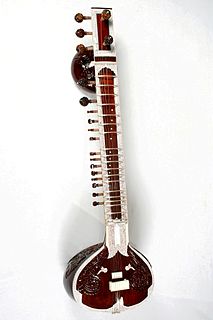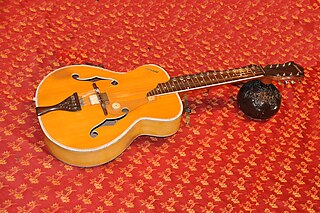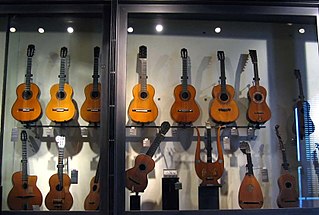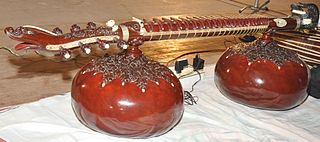
The classical guitar is a member of the guitar family used in classical music. An acoustic wooden string instrument with strings made of gut or nylon, it is a precursor of the modern acoustic and electric guitars, both of which use metal strings. Classical guitars are derived from the Spanish vihuela and gittern in the fifteenth and sixteenth century, which later evolved into the seventeenth and eighteenth-century Baroque guitar and later the modern classical guitar in the mid-nineteenth century.

The guitar is a fretted musical instrument that typically has six strings. It is held flat against the player's body and played by strumming or plucking the strings with the dominant hand, while simultaneously pressing selected strings against frets with the fingers of the opposite hand. A plectrum or individual finger picks may be used to strike the strings. The sound of the guitar is projected either acoustically, by means of a resonant chamber on the instrument, or amplified by an electronic pickup and an amplifier.
In music, a glissando is a glide from one pitch to another. It is an Italianized musical term derived from the French glisser, "to glide". In some contexts, it is distinguished from the continuous portamento. Some colloquial equivalents are slide, sweep, bend, smear, rip, lip, plop, or falling hail.

The sitar is a plucked stringed instrument, originating from the Indian subcontinent, used in Hindustani classical music. The instrument was invented in medieval India and flourished in the 16th and 17th centuries and arrived at its present form in 18th-century India.
The fingerboard is an important component of most stringed instruments. It is a thin, long strip of material, usually wood, that is laminated to the front of the neck of an instrument. The strings run over the fingerboard, between the nut and bridge. To play the instrument, a musician presses strings down to the fingerboard to change the vibrating length, changing the pitch. This is called stopping the strings. Depending on the instrument and the style of music, the musician may pluck, strum or bow one or more strings with the hand that is not fretting the notes. On some instruments, notes can be sounded by the fretting hand alone, such as with hammer ons, an electric guitar technique.

Fingerstyle guitar is the technique of playing the guitar or bass guitar by plucking the strings directly with the fingertips, fingernails, or picks attached to fingers, as opposed to flatpicking. The term "fingerstyle" is something of a misnomer, since it is present in several different genres and styles of music—but mostly, because it involves a completely different technique, not just a "style" of playing, especially for the guitarist's picking/plucking hand. The term is often used synonymously with fingerpicking except in classical guitar circles, although fingerpicking can also refer to a specific tradition of folk, blues and country guitar playing in the US. The terms "fingerstyle" and "fingerpicking" also applied to similar string instruments such as the banjo.
The chitravina is a 20 or 21-string fretless lute-style veena in Carnatic music. Around the late 19th and early 20th centuries, it started to be known by another name, Gotuvadyam, which was bestowed upon it by Sakha Rama Rao from Tiruvidaimarudur, who was responsible for bringing it back to the concert scene.

A Mohan Veena is either of two distinct plucked string instruments used in Indian classical music, especially Hindustani classical music which is associated with the northern parts of the Indian subcontinent. A modified sarod, created by sarod player Radhika Mohan Maitra in the 1940s, was called the mohan veena. The instrument was so named by musicologist Thakur Jaidev Singh, then the chief producer at All India Radio. Later Vishwa Mohan Bhatt modified a Hawaiian guitar to create an instrument also called the mohan veena, with Bhatt naming the instrument after himself. The latter instrument has become more closely associated with the name, especially following Bhatt winning the Grammy Award in 1994.

The following outline is provided as an overview of and topical guide to guitars:

The Rudra veena —also called Bīn in North India—is a large plucked string instrument used in Hindustani classical music, especially dhrupad. It is one of the major types of veena played in Indian classical music, notable for its deep bass resonance.

The vichitra veena (Sanskrit: विचित्र वीणा is a stick zither, a plucked string instrument used in Hindustani music. Similar to the Carnatic gottuvadhyam it has no frets and is played with a slide.

The Sarasvati vīṇa is an Indian plucked veena. It is named after the Hindu goddess Saraswati, who is usually depicted holding or playing the instrument. Also known as raghunatha veena is used mostly in Carnatic Indian classical music. There are several variations of the veena, which in its South Indian form is a member of the lute family. One who plays the veena is referred to as a vainika.
Gopal Shankar Mishra was an Indian musician and music teacher, who played the vichitra veena.

In classical guitar, the right hand is developed in such a way that it can sustain two, three, and four voice harmonies while also paying special attention to tone production. The index (i), middle (m), and ring (a) fingers are generally used to play the melody, while the thumb (p) accompanies in the bass register adding harmony, and produces a comparable texture and effect to that of the piano. The classical guitar is a solo polyphonic instrument, and it is difficult to master.

Guitar picking is a group of hand and finger techniques a guitarist uses to set guitar strings in motion to produce audible notes. These techniques involve plucking, strumming, brushing, etc. Picking can be done with:
The veena is a plucked musical instrument originating from India.

The Swarabat, Swarbat or Swaragat is a rare plucked string instrument of the classical Carnatic music genre of South India. It belongs to the chordophone, lute family of musical instruments, and is closely related to the veena and yazh instruments of the ancient South Asian orchestral ensemble.

The veena, also spelled vina, comprises a family of chordophone instruments from the Indian subcontinent. Ancient musical instruments evolved into many variations, such as lutes, zithers and arched harps. The many regional designs have different names such as the Rudra veena, the Saraswati veena, the Vichitra veena and others.

Triveni Veena is a plucked string musical instrument invented and patented by Pandit Niranjan Haldar along with Pandit Kamal Kamle. Pandit Niranjan Haldar is a retired senior Grade-A artist from All India Radio. He has more than 40 years of experience in Indian and Western classical music. He has presented Vichitra Veena and Guitar at various concerts and several events for Akashvani, Doordarshan and Sangeet Natak Akademi.

The eka-tantrī vīṇā was a medieval tube-zither veena in India, with a single string and one or more gourd resonators. The instrument became prominent in Indian music in about the 10th century C.E. as instruments of court music. Alongside the alapini vina and kinnari vina it replaced the harp-style veenas and lute-style veenas in sculpture. It was possibly a forerunner of the rudra vina. It shares its name with the modern single-string drone lute, the ektara.














